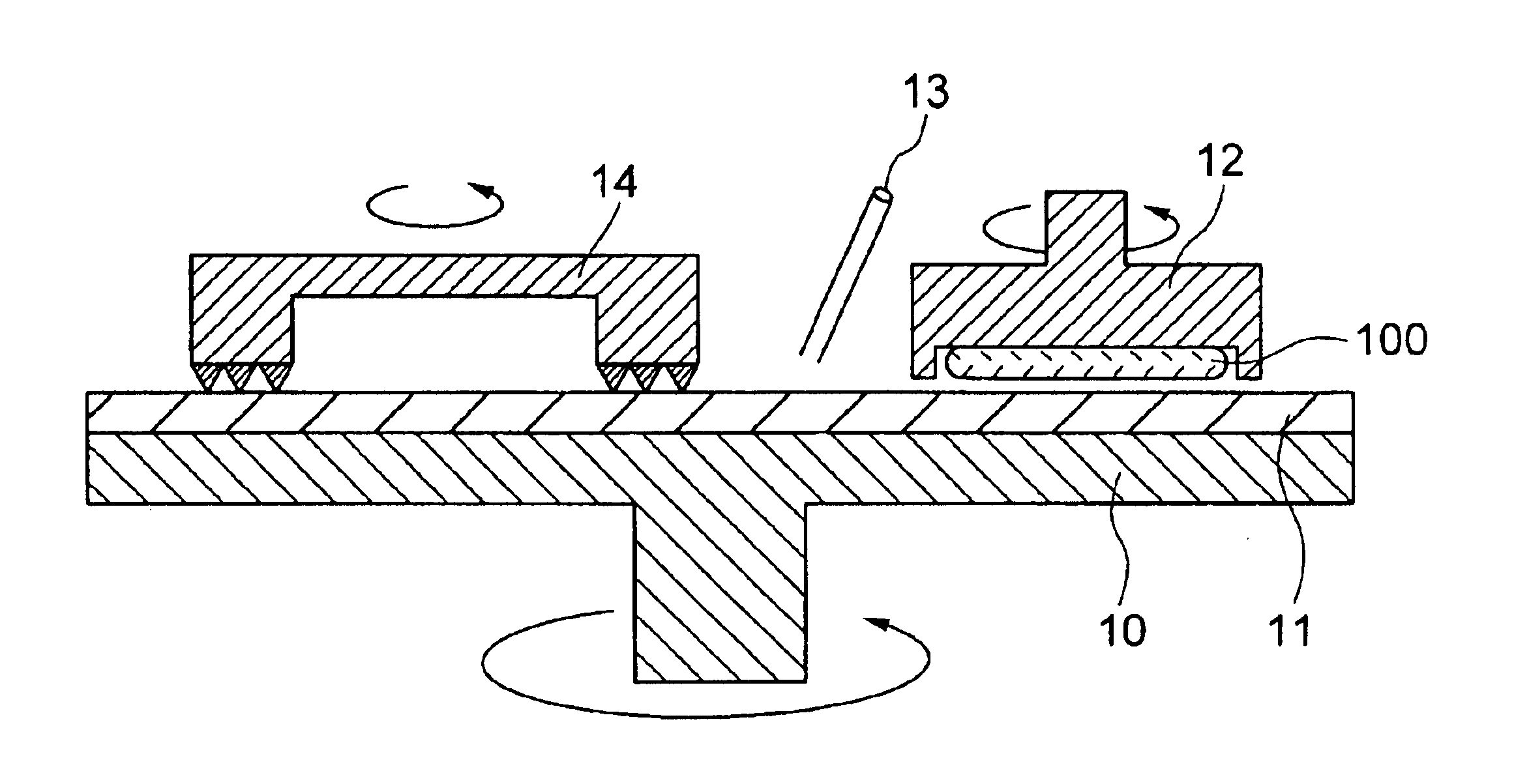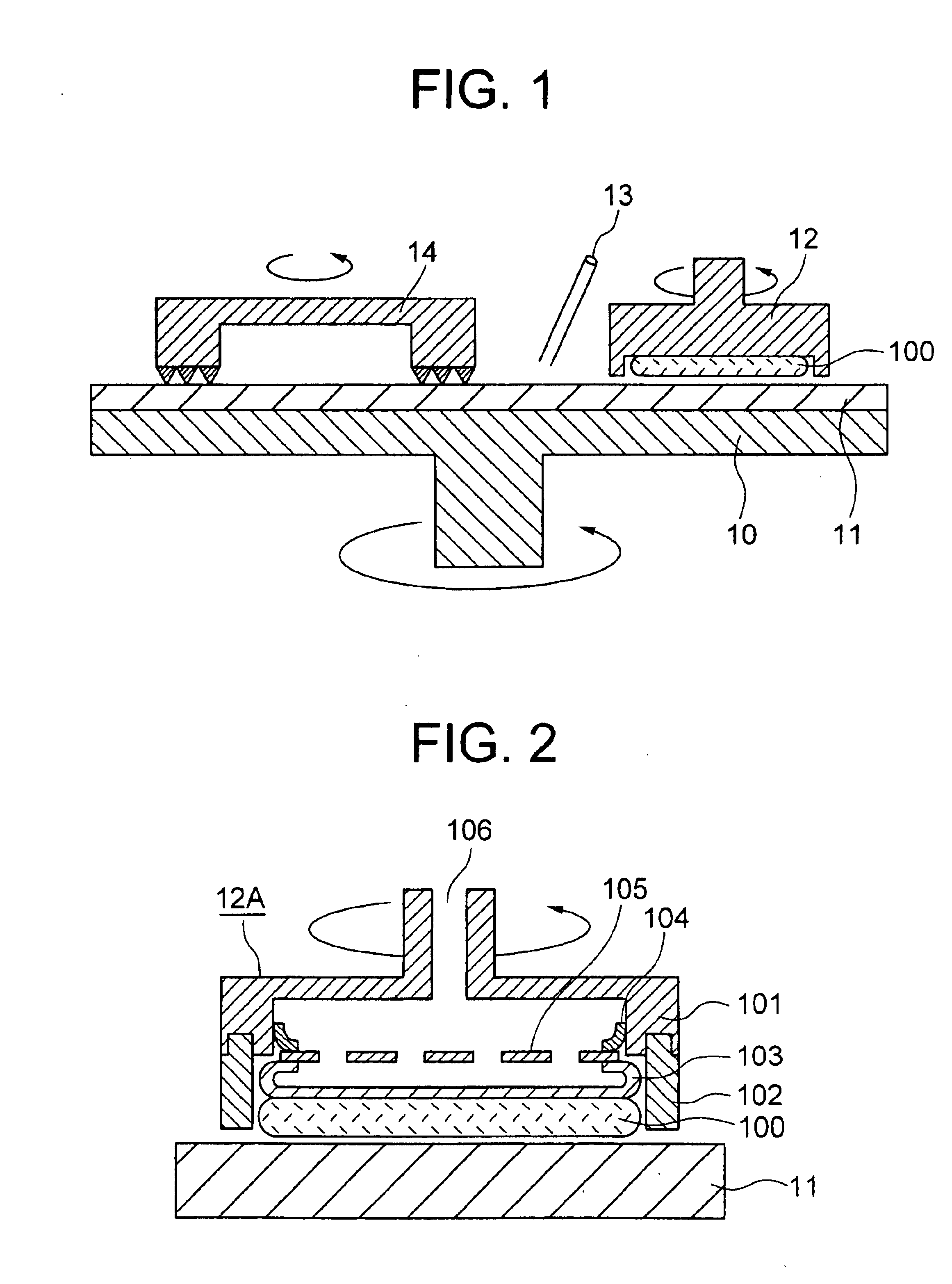Polishing apparatus
a technology of polishing apparatus and spherical blade, which is applied in the direction of grinding drives, manufacturing tools, lapping machines, etc., can solve the problems of increasing the hardness of the membrane and obtaining substantial effects, and achieves the effects of reducing the possibility of unstable polishing, generating polishing damage, and preventing unstable polishing
- Summary
- Abstract
- Description
- Claims
- Application Information
AI Technical Summary
Benefits of technology
Problems solved by technology
Method used
Image
Examples
example 1
[0055]FIG. 1 shows a cross section of main portion of a polishing apparatus used in the present invention. A polishing pad 11 is adhered onto main surface of a rotational polishing platen 10, and slurry (not shown) containing substantially no abrasive grain, is supplied by a supply inlet 13. Size of the polishing pad 10 is eighteen inch in diameter in examples described below as long as there is not any notification. A wafer 100 consisting of four-inch-diameter silicon wafer, on surface of which one-micron-thickness Cu film (not shown) is formed, is pressed onto the polishing pad 11, with the wafer covered with a cover body covering the wafer or by a holder body (a carrier) 12 holding the wafer. A dresser 14 to process surface of the polishing pad (so-called “dressing”), is mounted on another main portion of the polishing platen 10, and textures the surface of the polishing pad by rotating it with pressing.
[0056]A foamed polyurethane resin pad, IC1000 (trade mark of RODEL) was used ...
example 2
[0069]Polishing was performed in same condition as the example 1, except that a retainer shown in FIG. 6 or FIG. 7 was used.
[0070]Specifically, a retainer 202C of FIG. 6 is made from typical epoxide resin. In the retainer 202C, a plurality of grooves 203 with V-shape cross section of 10-500 micron depth are formed at least into inner wall that may contact with the membrane 103, substantially in parallel with surface (retainer polishing surface) of the retainer where retainer contacts with the polishing pad (hence laterally). It was founded that the depth variation of 10 to 500 micron was generated as follows. A retainer of resin is usually not accurate circle, and necessarily has a certain deformation. The retainer in this example was also deformed, thus depth of the deepest groove was 500 micron, and depth of the shallowest groove was 10 micron. Groove angle of the V-shaped groove 203 was about 90 degrees. The groove formation decreased surface area that can contacts with the membr...
example 3
[0073]A wafer was polished in same condition as the example 1, except that a retainer in FIG. 8 was used. The retainer 202A, 202C is made of material of typical epoxide resin. In the retainer, ring 202a made of tetrafluoro resin with low coefficient of friction is embedded into inner wall of a part that may contact with the membrane, and a plurality of grooves 203A with V-shaped cross section and about 100 micron depth is formed substantially in parallel with the polishing surface, hence laterally. Groove angle of the V-shaped groove 203A was about 90 degrees. Use of resin with low coefficient of friction as well as formation of the grooves allowed surface area that may contact with the membrane to decrease to half of the initial one.
[0074]A carrier with a retainer as shown in FIG. 8 is employed in a polishing apparatus, then a sample of wafer similar to one in the example 1 (an interconnect substrate) was polished. As a result, stable polishing was provided during copper polishing,...
PUM
| Property | Measurement | Unit |
|---|---|---|
| Force | aaaaa | aaaaa |
Abstract
Description
Claims
Application Information
 Login to View More
Login to View More - R&D
- Intellectual Property
- Life Sciences
- Materials
- Tech Scout
- Unparalleled Data Quality
- Higher Quality Content
- 60% Fewer Hallucinations
Browse by: Latest US Patents, China's latest patents, Technical Efficacy Thesaurus, Application Domain, Technology Topic, Popular Technical Reports.
© 2025 PatSnap. All rights reserved.Legal|Privacy policy|Modern Slavery Act Transparency Statement|Sitemap|About US| Contact US: help@patsnap.com



